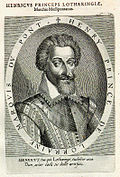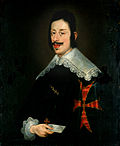| Name of Descendant | Portrait | Birth | Marriages and Issue | Death | Miscellaneous |
|---|
|
| Catherine Michaela of Spain |  | 10 October 1567, Daughter of Elisabeth of Valois and Philip II of Spain | Charles Emmanuel I, Duke of Savoy
10 children | 6 November 1597 | |
| Philip Emmanuel, Prince of Piedmont | | 2 April 1586, Son of Charles Emmanuel I, Duke of Savoy and Catherine Michaela of Spain | Unmarried, No issue | 9 February 1605 | |
| Isabella of Savoy |  | 11 March 1591, Daughter of Charles Emmanuel I, Duke of Savoy and Catherine Michaela of Spain | Alfonso III d'Este
14 children | 28 August 1626 | |
| Francesco I d'Este |  | 6 September 1610, Son of Alfonso III d'Este and Isabella of Savoy | Maria Caterina Farnese Vittoria Farnese Lucrezia Barberini 6 children
| 14 October 1658 | |
| Alfonso IV d'Este, Duke of Modena and Reggio | | 2 February 1634, Son of Francesco I d'Este and Maria Caterina Farnese | Laura Martinozzi 2 children | 16 July 1662 | |
| Isabella d'Este, Duchess of Parma | | 3 October 1635, Daughter of Francesco I d'Este and Maria Caterina Farnese | Ranuccio II Farnese, Duke of Parma 3 children | 21 August 1666 | |
| Eleonora d'Este | | 2 January 1643, Daughter of Francesco I d'Este and Maria Caterina Farnese | Became a Carmelite nun; No issue | 24 February 1722 | |
| Maria d'Este, Duchess of Parma and Piacenza | | 8 December 1644, Daughter of Francesco I d'Este and Maria Caterina Farnese | Ranuccio II Farnese, Duke of Parma 7 children | 20 August 1684 | |
| Rinaldo d'Este, Duke of Modena and Reggio | | 26 April 1655, Son of Francesco I d'Este and Lucrezia Barberini | Charlotte of Brunswick-Lüneburg 8 children | 26 October 1737 | |
| Victor Amadeus I, Duke of Savoy |  | 8 May 1587, Son of Charles Emmanuel I, Duke of Savoy and Catherine Michaela of Spain | Christine Marie of France
8 children | 7 October 1637 | |
| Princess Luisa Cristina of Savoy | | 27 July 1629, Daughter of Victor Amadeus I, Duke of Savoy and Christine Marie of France | Prince Maurice of Savoy No issue | 12 May 1692 | Her husband was her uncle, he was her fathers younger brother |
| Charles Emmanuel II, Duke of Savoy |  | 20 June 1634, Son of Victor Amadeus I, Duke of Savoy and Christine Marie of France | Françoise Madeleine d'Orléans No issue
Marie Jeanne of Savoy
1 child | 12 June 1675 | |
| Victor Amadeus II of Sardinia |  | 14 May 1666, Son of Charles Emmanuel II, Duke of Savoy and Marie Jeanne of Savoy | Anne Marie d'Orléans
Anna Teresa Canalis di Cumiana
8 children | 31 October 1732 | |
| Maria Vittoria of Savoy, Princess of Carignano | | 9 February 1690, illegitimate Daughter of Victor Amadeus II of Sardinia and Jeanne Baptiste d'Albert de Luynes | Victor Amadeus I, Prince of Carignan 5 children | 8 July 1766 | |
| Vittorio Francesco, Marquis of Susa | | 10 December 1694, illegitimate Son of Victor Amadeus II of Sardinia and Jeanne Baptiste d'Albert de Luynes | Maria Lucrezia Franchi No issue | 20 March 1762 | |
| Princess Henriette Adelaide of Savoy |  | 6 November 1636, Daughter of Victor Amadeus I, Duke of Savoy and Christine Marie of France | Ferdinand Maria, Elector of Bavaria
4 children | 18 March 1676 | |
| Duchess Maria Anna Victoria of Bavaria |  | 28 November 1660, Daughter of Princess Henriette Adelaide of Savoy and Ferdinand Maria, Elector of Bavaria | Louis, Dauphin of France
3 children | 20 April 1690 | |
| Maximilian II Emanuel, Elector of Bavaria |  | 11 July 1662, Son of Princess Henriette Adelaide of Savoy and Ferdinand Maria, Elector of Bavaria | Maria Antonia of Austria
Theresa Kunegunda Sobieska
5 children | 26 February 1726 | |
| Emmanuel Philibert of Savoy, Viceroy of Sicily | | 16 April 1588, Son of Catherine Michaela of Spain and Charles Emmanuel I, Duke of Savoy | Unmarried, No issue | 4 August 1624 | |
| Margaret of Savoy, Vicereine of Portugal |  | 28 April 1589, Daughter of Catherine Michaela of Spain and Charles Emmanuel I, Duke of Savoy | Francesco IV Gonzaga, Duke of Mantua
1 child | 26 June 1655 | |
| Maria Gonzaga, Duchess of Montferrat |  | 29 July 1609, Daughter of Margaret of Savoy, Vicereine of Portugal and Francesco IV Gonzaga, Duke of Mantua | Charles II Gonzaga
2 children | 14 August 1660 | |
| Charles II Gonzaga, Duke of Mantua and Montferrat | | 31 October 1629, Son of Charles II Gonzaga and Maria Gonzaga, Duchess of Montferrat | Archduchess Isabella Clara of Austria 1 child | 30 August 1631 | |
| Ferdinando Carlo Gonzaga, Duke of Mantua and Montferrat | | 14 August 1665, Son of Charles II Gonzaga, Duke of Mantua and Montferrat and Archduchess Isabella Clara of Austria | Anna Isabella Gonzaga Suzanne Henriette of Lorraine No issue | 5 July 1708 | |
| Eleanor Gonzaga |  | 18 November 1630, Daughter Maria Gonzaga, Duchess of Montferrat and Charles II Gonzaga | Ferdinand III, Holy Roman Emperor
2 children | 6 December 1686 | |
| Eleonora Maria of Austria, Queen of Poland, Duchess of Lorraine |  | 31 May 1653, Daughter of Eleanor Gonzaga and Ferdinand III, Holy Roman Emperor | Michał Korybut Wiśniowiecki, King of Poland and Grand Duke of Lithuania
Charles V, Duke of Lorraine
2 children | 17 Dec 1697 | Husband = Charles V, Duke of Lorraine under Progeny of Henry II, Duke of Lorraine |
| Leopold the Good, Duke of Lorraine | | 11 September 1679, Son of Charles V, Duke of Lorraine and Eleonora Maria of Austria | Élisabeth Charlotte d'Orléans 14 children | 27 March 1729 | |
| Charles Joseph of Lorraine, Bishop of Olomouc | | 24 November 1680, Son of Charles V, Duke of Lorraine and Eleonora Maria of Austria | No issue | 4 December 1715 | |
| Archduchess Maria Anna Josepha of Austria | | 20 December 1654, Daughter of Eleanor Gonzaga and Ferdinand III, Holy Roman Emperor | Johann Wilhelm, Elector Palatine 2 children, both died in infancy | 4 April 1689 | |
| Prince Maurice of Savoy | | Son of Catherine Michaela of Spain and Charles Emmanuel I, Duke of Savoy | Princess Luisa Cristina of Savoy No issue | 3 October 1657 | His wife was his niece, the daughter of his brother Victor Amadeus I, Duke of Savoy and Christine of France |
| Thomas Francis, Prince of Carignano |  | 21 December 1596, Son of Catherine Michaela of Spain and Charles Emmanuel I, Duke of Savoy | Marie de Bourbon, Countess of Soissons
7 children | January 22, 1656 | |
| Princess Louise of Savoy | | 1 August 1627, Daughter of Thomas Francis, Prince of Carignano and Marie de Bourbon, Countess of Soissons | Ferdinand Maximilian, Hereditary Prince of Baden-Baden 1 child | 7 July 1689 | |
| Emmanuel Philibert, Prince of Carignano | | 20 August 1628, Son of Thomas Francis, Prince of Carignano and Marie de Bourbon, Countess of Soissons | Maria Angela Caterina d'Este 4 children | 23 April 1709 | |
| Eugene Maurice, Count of Soissons | | 2 March 1635, Son of Thomas Francis, Prince of Carignano and Marie de Bourbon, Countess of Soissons | Olimpia Mancini 8 children | 6 June 1673 | |





























































